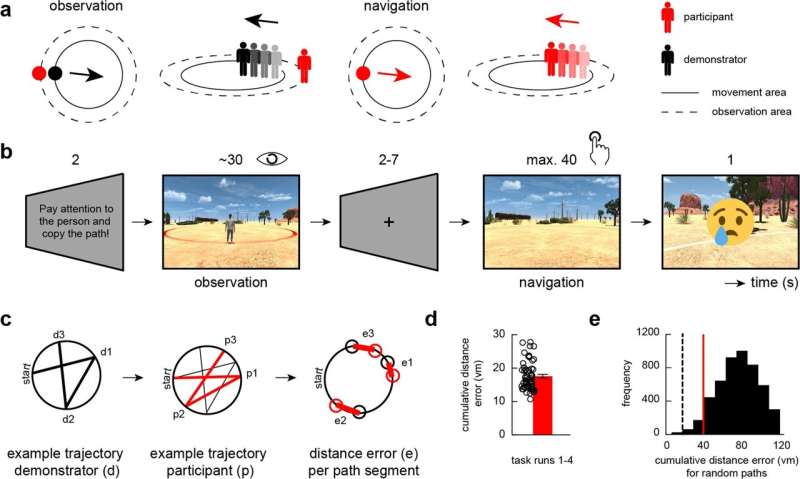Modified navigation task. a The task projected participants into a first-person perspective within a virtual reality (VR) environment while they were asked to observe and subsequently re-trace the paths of a demonstrator. The movement area was marked with a red circle on the sandy desert plane and was surrounded by an observation area (solid and dashed circles in bird’s eye and street views, respectively). During observation (left panel), participants were placed directly behind the demonstrator’s starting point, were not able to move, and viewed the demonstrator walking through the circular arena (movement trajectory schematically indicated). During navigation (right panel), the demonstrator disappeared and the participant was projected onto the same starting position to re-trace the previously observed path. b Timeline of one example trial during the modified navigation task (s, seconds). A performance threshold of 20 virtual meters (vm) determined the feedback that participants received on each trial (i.e., happy emoji, cumulative distance error ≤ 20 vm; sad emoji, cumulative distance error > 20 vm). c Example path of demonstrator and participant obtained from observation and navigation periods, respectively. A trial comprised three random path segments that each started and ended at the edge of the movement area (i.e., participants observed/walked paths from one edge to the other and were not able to stop and turn within the movement area). We then calculated the distance error per path segment, yielding the cumulative distance error per trial. d Average cumulative distance error within the sample (N = 58). Error bars reflect the standard error of the mean, s.e.m. e Permutation distribution obtained from simulating the paths of a random agent 5000 times (“Methods”). Chance level was calculated as the 5th percentile of the distribution, yielding a value of 39.3 vm (red line). The dashed line indicates the value of the observed group mean (17.57 vm, shown in d). Credit: Nature Communications (2023). DOI: 10.1038/s41467-023-35819-3
Grid cells not only help us navigate our own paths in a complex environment, but also help us analyze the movements of other people, scientists from the University of Vienna have now shown for the first time. Their new study in Nature Communications also suggests an explanation for a mechanism that could lead to disorientation in dementia patients.
Whether you are making your way through a crowded pedestrian zone or striving towards the goal in a team game, in both situations it is important to think not only about your own movements but also those of others. These navigation and orientation processes are carried out by brain cells that register our current position, where we are coming from, where we are moving towards and in which direction we are looking.
Through their joint activity, they create a "map" of our surroundings. A special type of these cells are the so-called grid cells in the entorhinal cortex, a small brain region in the middle temporal lobe. They function like the brain's own GPS, because they not only represent our position in space, but can also put it in relation to other points in the same space.
Whether these grid cells are also involved in mapping the movements of other individuals on this map was the question that the scientists led by Isabella Wagner and Claus Lamm from the Faculty of Psychology at the University of Vienna addressed. For this purpose, the scientists tested participants that either navigated themselves in a virtual environment, or observed the movements of another person while their brain activity was measured using functional magnetic resonance imaging (fMRI).
They found that the brain activity recorded while watching others was comparable to the activity of grid cells. In addition, the team was able to show that this activity was part of a larger network of brain regions that are associated with navigation processes. Interestingly, however, it turned out that the better a subject was at following the path of others, the less active this network was. "We interpret this as greater efficiency of the grid cells, which might make it less necessary to engage the larger brain network," Wagner explains.
The results of the study thus suggest that grid cells belong to a larger network of brain regions that, among other aspects, coordinates navigation processes. However, this network is particularly affected by aging processes and especially by dementia.
Wagner explains, "The function of grid cells decreases with age and dementia. As a result, people can no longer find their way around and their orientation is impaired." The group's further research is now dedicated to the question of whether grid cells are also involved in recognizing other people—an aspect that is often impaired in advanced dementia.
More information: Isabella C. Wagner et al, Entorhinal grid-like codes and time-locked network dynamics track others navigating through space, Nature Communications (2023). DOI: 10.1038/s41467-023-35819-3
Journal information: Nature Communications
Provided by University of Vienna























